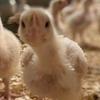Conventional broiler (meat) chickens reach a final weight of 6.6 lbs (3 kg) in approximately 40-44 days. Across their lifetime, these fast-growing birds gain an average of 68-75 g per day, with daily gain increasing with age (Aviagen, 2022; Cobb, 2022).
With their fast growth, however, they can be prone to cardiovascular and musculoskeletal diseases (Hartcher and Lum, 2020; PEC newsletter vol. 31). In addition, fast-growing broilers spend more time eating and resting rather than being active (Dixon, 2020). To improve animal welfare outcomes, companies are considering raising slower-growing chickens.
From jungle fowl to meat bird
Chicken husbandry became a practice roughly 8,000 years ago during the Holocene era in East Asia (Peters et al., 2016).
The domestication led to the development of different chicken breeds that are used in the poultry industry today (Al-Nasser et al., 2006). Changes imposed by divergent genetic selection by humans have led the modern meat chicken (Gallus gallus domesticus) to change greatly compared to their ancestor, the Red Junglefowl (Gallus gallus), which is still prevalent in Asia today.
Genetic selection is different from genetic modification, as humans select animals with favorable traits to breed rather than changing animal's genes using technology. Broiler genetic selection has favored traits that increase production value, such as fast growth rate, low feed conversion, and large breast muscles (Tavárez & de los Santos, 2016).
The threshold for average daily gain for strains to be considered slow-growing differs among stakeholders, but a commonly mentioned threshold is < 50 g/day over their life span (G.A.P., 2016; Rayner et al., 2020).
Why do farmers still use fast-growing birds over slow-growing birds?
Slow-growing broilers take longer to grow to the preferred size, weight, or age, which has both economic and environmental impacts.
Since the birds grow slowly, farmers can produce fewer flocks within a year. Slow-growing birds require more feed, thus are more expensive to raise.
If producers were to switch from a fast- to a slow-growing broiler, it would cost them 11-25% more per lb of meat raised (Lusk et al., 2019). In order to make up for these cost increases, consumers would need to pay a premium of $0.10/lb-$0.36/lb (Lusk et al., 2019).
To produce the additional chicken feed, 35% more land and 40% more water is required. Birds will also produce more manure that will need to be disposed of (ELANCO, 2016).
Economic considerations for raising slow-growing broiler chickens (Elanco, 2016). Each icon represents an additional 10% of that resource required or produced when raising a slow-growing broiler flock compared to a fast-growing broiler flock.
How common are slow-growing broilers today?
Because differences in health and behavior between fast and slow-growing strains mainly stem from genetic selection pressures, consumers have expressed a preference for slow-growing broilers (Hall & Sandilands, 2006). The current U.S. market share of slow-growers is unknown, but very small. In other countries, slow-growing broilers make up approximately:
- 40% of broiler chicken flocks in the Netherlands (Roxell, 2022)
- 15% of flocks in France (Hubbard, 2016)
- 11% of flocks in the United Kingdom (Rayner, 2020)
Some animal welfare programs and assurance schemes are focusing their requirements (in part) on genetic strains. For instance, Global Animal Partnership is requiring all broilers under their certification to be from slow-growing strains by 2024 (G.A.P., 2016).
In addition, some voluntary programs are focusing on growth rate. One of these is The Better Chicken Commitment. This group is requiring any broilers raised under their standards to be from slow-growing strains by 2026 (B.C.C., 2022).
Summary: fast- vs slow-growing broilers
Fast-growing broilers have been genetically selected for very efficient growth and muscle development, but can be prone to issues with their health and behavior (see PEC newsletter vol 31).
One way to address these is to use slower-growing strains for meat production. However, since the birds grow slowly, they are more costly to raise and have a greater impact on the environment.
While attempting to balance animal welfare, economics, and environmental impacts, the use of slow-growing birds in commercial broiler meat production is increasing, especially in Europe, and the United States.
To read part one, click here. 


















.jpg&w=3840&q=75)